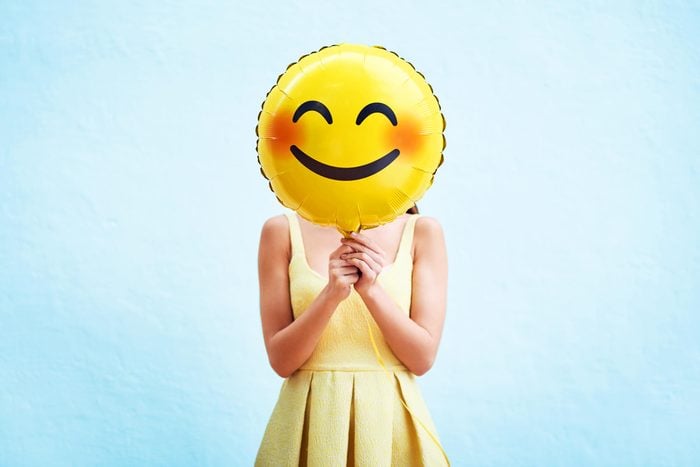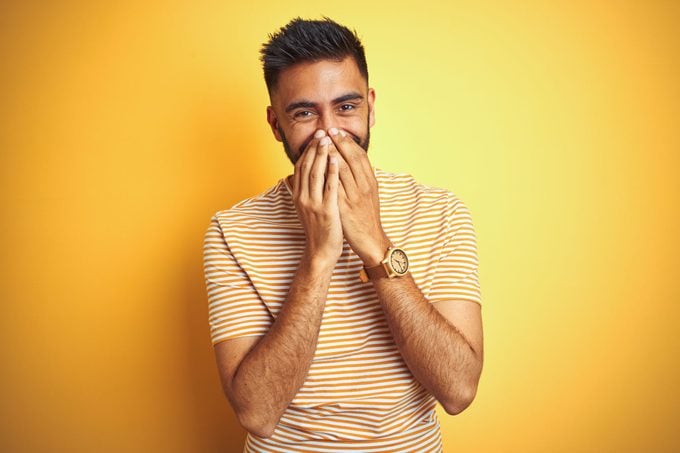You’re Blushing! The Science Behind Those Rosy Cheeks
Updated: Dec. 14, 2023

Turning beet red is never fun, but the science behind why people blush, a uniquely human phenomenon, sure is fascinating
You’re 12 years old again, and your middle school crush just asked you to dance. Before you can say yes, you notice your entire grade is watching. You can feel it happening, but you can’t control it: Your heart races, the heat rises up from somewhere inside, and your face feels like it’s steaming. You’re blushing, and there’s no hiding your embarrassment. If just reading that bit of déjà vu makes you blush (or want to run away screaming), you’re not alone. Blushing is a uniquely human reaction, and one we’ve all experienced at some point. But why do people blush?
Blushing is actually a bit of a scientific mystery, and one of the many weird facts about the human body. While it has been extensively studied, it’s not exactly clear why it happens. Unlike other emotional responses (why do we laugh?), blushing is more varied. “It’s a very complex reaction,” says Gary Small, MD, chair of psychiatry at the Hackensack University Medical Center in New Jersey and leading expert on brain science. “Blushing doesn’t mean the same thing for every person. Not everyone blushes at the same rate or has the same propensity to blush.”
Want to dive into the many mysteries of blushing? Here’s what the experts (and research) have to say.
Get Reader’s Digest’s Read Up newsletter for more trivia, humor, cleaning, travel, tech and fun facts all week long.
Why do people blush?
“If you’re embarrassed or ashamed, that’s when people tend to blush,” says Dr. Small. It’s an involuntary response to insecurity, embarrassment or simply an awkward social situation.
Charles Darwin called blushing “the most peculiar and most human of all expressions,” and it’s true that no other animal on earth blushes the way we do. It’s a puzzling human characteristic (unlike the rarest eye color or the rarest hair color, which are genetic traits). And although blushing as a form of communication has actually been observed in some other animals (like parrots), it doesn’t work quite the same way. Blushing in humans is really a result of our existence as social creatures and our complicated social structures.
What happens in your body when you blush?
When we feel embarrassment or shame, it triggers the same bodily system as the fight-or-flight response. “There’s an emotional trigger that causes a physiological response,” Dr. Small says. “The glands release adrenaline to your body, which causes the widening of capillaries, so blood comes closer to the surface, and you see the redness.”
Why would we experience embarrassment the same way we experience fear or stress? Embarrassment or shame are both examples of what scientists refer to as “social pain.” Because our survival as a species is so dependent on our sense of belonging, we evolved to experience social pain as deeply as physical pain. Being cast out of the group is as dangerous to humans as physical threats, like being chased by a tiger.
How did blushing evolve?
While there are many theories as to when and exactly how blushing evolved, the reasons behind it really boil down to the survival benefits of being liked. “Blushing elicits empathy from the observer,” Dr. Small says. “It builds bonds. That’s key for human survival.”
Humans are social animals who have thrived thanks to being part of a community. “If you’re in a group, you have an advantage over predators. You can protect each other. You can divvy up chores, making it easier to feed your young,” Dr. Small says. This type of collaboration requires a shared set of social rules and a lot of trust. When a member of the group commits a social transgression or otherwise makes a mistake, it benefits the entire group if the rift can be mended with a sincere apology.
Researchers studying blushing have found that blushing may communicate a sincere apology better than other mannerism. One 2020 study tested this idea by sharing a story of a social situation—in one example, they explained that someone had been caught in a lie—and then showed pictures of the faces of people involved. The pictures featured both blushing and non-blushing faces. Researchers asked the study participants to judge how embarrassed, sincere or trustworthy they felt the people in the pictures were. In the end, after three different experiments, researchers found the blushing faces were most likely to be rated as the most embarrassed as well as the most sincere and trustworthy.
Even when the blushing was combined with more negative or off-putting facial expressions, like anger, the blushing faces still communicated sincerity and trustworthiness. This suggests that blushing—and the fact that it is automatic—may have evolved to protect us from the consequences of our more destructive impulses, such as saying stuff we don’t mean when we’re angry or becoming defensive or anti-social when we’re caught red-handed. “Think about it: When someone gets defensive in a social situation, it can be off-putting,” Dr. Small says. “But when someone blushes, it’s an admission of their humanity.”
What causes blushing?

Because it’s a physiological response (similar to why we yawn), the physiological (how) is a bit easier to explain than the psychological (why). You first have to consider what counts as blushing. There are many reasons someone might flush or turn red, including exposure to heat or cold, medication side effects, drinking alcohol or physical exertion, to name a few. But these causes of turning red are more physiological than blushing. Other emotions, such as passion, nervousness or rage can also cause flushing. But true blushing—which is instant and automatic—is generally thought by psychologists to be associated with emotions related to self-consciousness and how we think we appear to others.
These types of emotions involve some of our most complex feelings, which may be why some of us are more affected by blushing than others, Dr. Small says. Triggers for blushing can include the following.
Embarrassment
This is the first emotion people think of when it comes to blushing, of course. If you commit a social faux pas, blushing is a normal response. Embarrassment stems from a fear that something you’ve done or participated in is going to change how others see you. If you trip and fall walking across the stage at graduation, it’s embarrassing because people you know may now view you as clumsy or unserious. The reasons we blush are highly dependent on how we were raised and the social codes we live by. For example, for someone from a very conservative, religious background, saying or even hearing a curse word may elicit an immediate blush. For someone with a different upbringing, a curse word may be just another part of their vocabulary, Dr. Small says.
Feeling exposed
Blushing tends to happen when everyone is looking. That’s because one of the main causes is feeling exposed or open to scrutiny. This can happen when something about you is revealed to the group, especially if it’s something you want to keep private. For example, a group of people just found out you have a crush on someone or that you still sleep with a stuffed animal.
Positive attention or praise
This is one of the more curious causes of blushing because, of course, praise isn’t a bad thing! But praise, especially excessive praise, may cause blushing because it opens you to scrutiny. For some people, this can create the same anxiety you may feel when you’ve committed a social faux pas. Now that you’ve been noticed, you may fear that you’ll mess up.
Do some people blush more than others?
Yes, some people seem more prone to blushing than others, and it could be an inherited trait. But why do some people blush at a higher rate? “It’s a combination of genetics and environment,” Dr. Small says. “There may be some genetic link between certain personality traits and blushing. If you have a predisposition toward social anxiety, you may blush more frequently,” he says. One 2015 study found that “frequent blushers” tended to feel more shame and tended to have fewer dominant behaviors than those who were “infrequent blushers.” Everyone is going to be different in terms of what triggers a blush.
Can you prevent blushing?
Blushing is really hard to prevent. That said, because of the psychological components of blushing, mental health therapies such as cognitive behavioral therapy may be effective at helping you better manage feelings of shame and embarrassment or social anxiety that lead to blushing, Dr. Small says. For people with very severe blushing, there is actually a surgical technique known as endoscopic thoracic sympathicotomy (ETS) that can be used to disconnect the nerve pathways responsible for turning your face red. But surgery is usually reserved for treating people who flush due to physical disorders, rather than social anxiety or another psychological cause.
How to stop blushing
Once you start blushing, you can’t stop it, Dr. Small says. It’s an automatic response. That said, there are things you can do to help yourself recover.
Acknowledge your mistake
“To err is human, as they say,” Dr. Small says. The faster you acknowledge your mistake, the sooner you can resolve the psychological tension that led to the blush in the first place. Remember that the whole point of blushing is to communicate to your peers that you’re sincere and worthy of membership in the group. Just saying you’re sorry can help you feel better and calm the blushing in the process.
Smile
Smiling during stressful events may help tame the stress response and make the responses easier to weather, according to one oft-cited 2012 study. Many of the same mechanisms in the stress response are present when we blush, so smiling through a flush may help resolve it faster.
Take a deep breath
A deep breath (or two or three) may also help calm the stress response activated during blushing and restore equilibrium.
About the expert
- Gary Small, MD, is one of the world’s leading experts on brain science and has published numerous books and articles. He is a professor and chair of psychiatry at Hackensack University Medical Center and was previously a professor of psychiatry and biobehavioral sciences at the David Geffen School of Medicine at UCLA, director of the division of geriatric psychiatry at the Semel Institute for Neuroscience and Human Behavior, and director of the UCLA Longevity Center. Dr. Small invented the first brain scan that allows doctors to see the physical evidence of brain aging and Alzheimer’s disease in living people, and Scientific American magazine named him one of the world’s top innovators in science and technology.
Sources:
- Oxford Academic: “Darwin, Blushing and Love”
- Public Library of Science: “Facial display and blushing: Means of visual communication in blue-and-yellow macaws”
- American Scientist: “Embarrassment: A Form of Social Pain”
- Cognition and Emotion: “Facial blushing influences perceived embarrassment and related social functional evaluations”
- The British Psychological Society: “The Puzzle of Blushing”
- Journal of Child Psychology and Psychiatry: “The unique contribution of blushing to the development of social anxiety disorder symptoms: results from a longitudinal study”
- Medicine (Baltimore): “Surgical treatment of facial blushing: Patient selection and operative technique (retrospective observational study)”



